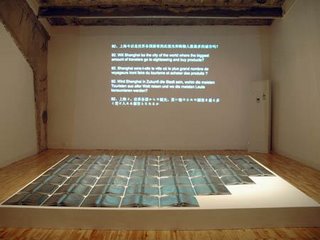
This exhibition features Liu Jian Hua, who commenced the evolving process of nurturing his aesthetic development and métier as a sculptor early on in his career. Subsequently he succeeds in refining several of his signature motifs that are embedded in his entire body of works. The purity of line created by the use of white porcelain ceramics and his alertness to his mercurial environment render artworks that are artistically and socially relevant.
Liu Jian Hua’s artworks present an unflinching illumination of the all too intimate relationship between materialism and humanity. These questions and issues that are raised in his artworks are for instance evident in works like “Do You have an answer?” This artwork is a mixed-media piece wherein Liu Jian Hua uses both stainless steel sculpture and technology to create a singularly unique work. A projection of text comprised of rhetorical questions is tantamount to the stainless steel books themselves. This work has the goal of stimulating the viewer’s own insights on the current state of contemporary Chinese Society. These are questions that penetrate the fabric of day-to-day modern Chinese life. They also suspend our former assumptions on contemporary Chinese society for the more important issues it raises, such as how Modernity and rapid urbanization are defined within the specific context of Shanghai, Beijing, Guangzhou, or any other major Chinese Cosmopolis?
The artwork “Floating Object” is likewise a piece that evokes a myriad of interpretations pertaining specifically to the forum of Chinese political life. A floating glass sculpture of an island is set against the projected backdrop of Eastern Asia; the island being a clear representation of Taiwan. When viewers venture in for a closer look at the glass Taiwan, mini ceramic sculptures of pandas are seen inhabiting its terrain. This artwork in fact has significant correlations to actual events. Pandas, one of the most prominent symbols for China were given to Taiwan as a political gesture to promote more friendly ties. Like his other works, the interpretative dialogue remains open for viewers to arbitrate a meaning on their own.
“Reflection-Mirror Illusion”, made from white porcelain celadon, is a 12 metre long sculpture depicting the hyper-cosmopolitan skylines of Shanghai, Beijing and Shenzhen. This piece is hung on a white wall, with site-specific spotlights to render a silhouette effect. The sculpted buildings, upon closer examination, are in fact crooked, to symbolize the fact that they are a mere reflection of the west. Like a true reflection, the silhouette is temporary and transient, giving the overall piece an ominous veneer. This piece exudes again highly relevant issues such as massive rapid urbanization and its effects on traditional Chinese architecture and modernization.
“Beijing Olympic Commemoration” is a painting by Liu Jian Hua that satirizes a photograph taken during the Olympic games in Greece, with the intention of dedicating a pastiche to the German painter Gerhard Richter.
Time and again, Liu Jian Hua’s artworks delve into subjects that are at the heart of current Chinese culture. The visual and cognitive experience of viewing a Liu Jian Hua work is immediate, and often evocative of the animated and multi-valent relationships between people and their surroundings. Through his sensitivity and powers of observation that are evident in his works, Liu Jian Hua comments lucidly on the changing world.
Liu Jian Hua is exhibiting for the first time with Galleria Continua in Beijing. His presence confirms the continuation of Galleria Continua’s mandate of preserving and nurturing the dialogue between the east and the west.
 Yoshiko Matsumoto Gallery is pleased to present ‘Video Killed the Painting’, an exhibited curated by Bart de Koning Gans, which will be on view from December 27, 2006 until February 3, 2007.Our language of immediacy has made us hungry for quick imagery, however video art teaches us to 're'-observe by taking our time to look. True it is very annoying when it is bad but when it is good the reward is worth the wait. Video forces us to view, listen and take time to adjust. Paintings and sculptures can more easily be divided into bad and good with a brief glance, yet with video it demands your time. This exhibit features 4 video artists whom interpret various stages of the human mind and its behavior.
Yoshiko Matsumoto Gallery is pleased to present ‘Video Killed the Painting’, an exhibited curated by Bart de Koning Gans, which will be on view from December 27, 2006 until February 3, 2007.Our language of immediacy has made us hungry for quick imagery, however video art teaches us to 're'-observe by taking our time to look. True it is very annoying when it is bad but when it is good the reward is worth the wait. Video forces us to view, listen and take time to adjust. Paintings and sculptures can more easily be divided into bad and good with a brief glance, yet with video it demands your time. This exhibit features 4 video artists whom interpret various stages of the human mind and its behavior.




